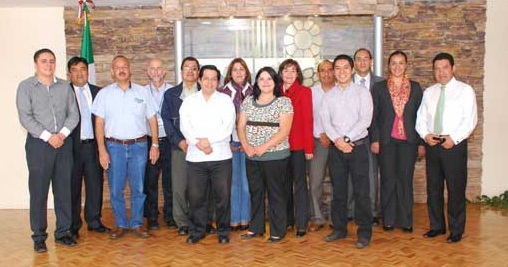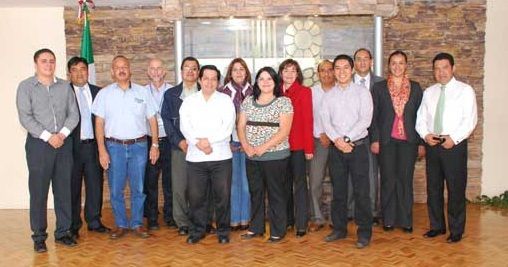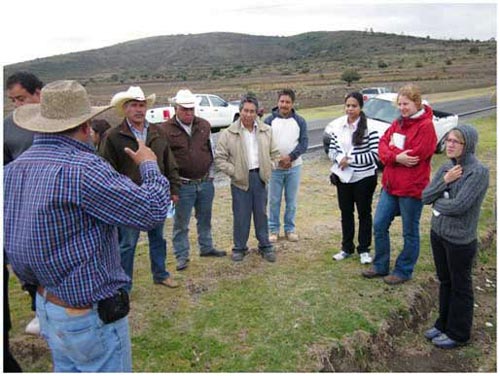INIFAP visit
As part of a Mexican government initiative to enhance the quality and service of its research organizations, on 20 September 2011 a team of specialists from the National Institute of Forestry, Agriculture, and Livestock Research (INIFAP) spent the day at El Batán interacting with CIMMYT staff on respective organizational cultures and values, missions and visions, research and business plans, and professional development.
 Launching the visit with an overview of INIFAP, forestry support director Juan Bautista Rentería Anima described a rich and challenging research agenda keyed to Mexico’s diverse native crops and cropping environments. “In recent years the emphasis has again shifted to extension,” said Rentería, “trying to reach farmers with our products.”
Launching the visit with an overview of INIFAP, forestry support director Juan Bautista Rentería Anima described a rich and challenging research agenda keyed to Mexico’s diverse native crops and cropping environments. “In recent years the emphasis has again shifted to extension,” said Rentería, “trying to reach farmers with our products.”
Prefacing an introduction to CIMMYT, corporate communications head Mike Listman remarked on the strong parallels in scientific and institutional challenges facing both organizations. “I guess it shouldn’t come as a surprise, but we’re talking the same language on these issues” he said. The origins and evolution of CIMMYT are linked to INIFAP history, the director of the institute, Dr. Pedro Brajcich Gallegos, served as a CIMMYT wheat breeder, and both Brajcich and Salvador Fernández-Rivera, INIFAP Coordinator for Research, Innovation, and Partnerships, currently serve as CIMMYT Trustees.
Karen García, executive director of the Sustainable Modernization of Traditional Agriculture (MasAgro) project launched in 2010, highlighted the key role of INIFAP in the Mexico-funded initiative.
Presentations by Luz George, head of the project management unit, Carolina Roa, head of the intellectual property unit, and Carlos López, head of information and communications technology, addressed services and applications offered by those areas. Bibiana Espinosa, research assistant in wheat genetic resources, also took part in discussions. The event was organized by Isabel Peña, head of interinstitutional relations in Latin America.
The INIFAP team thanked CIMMYT warmly for its hospitality and open sharing of information. In a closing session, Scott Ferguson, deputy director general for support services, thanked the visitors for coming, and emphasized that CIMMYT is still finding its way to more efficient systems and structures: “We’ve doubled our budget over the four years, after 28 years of zero growth in real terms. We are dealing with all the organizational problems of such rapid and dramatic growth, and appreciate the chance to share experiences and ideas with a longstanding partner.”
The INIFAP group comprised Bertha Patricia Zamora, Director of Programs and Strategic Projects; Juan Bautista Rentería Anima, Director of Forestry Support; Vicente Santacruz García, Director of Planning; Ceferino Ortiz Trejo, Director of linking Operative Units; Héctor Peña Dueñas, Director of Human Development and Professionalism; Ramsés Gutiérrez Zepeda, Director of Evaluation and Systems; Francisco González Naranjo, Dirección of Efficiency and Accountability; Ricardo Noverón Chávez, Head of the Legal Unit; Edmundo Márquez Santana; Director of Scientific Exchange and Cooperation; Miguel Ignacio Moneta Porto, Head of Strategic Information Consolidation; and Omar Chávez Aguilera, Head of Agreements for Scientific Cooperation.

 India has recently experienced a boom in cell phone use in the agricultural sector—disseminating information on anything from technology to agronomic practices, weather, or even market prices. Investigating this recent trend’s presence in Mexico, on June 26 a team of CIMMYT socioeconomists including Tina Beuchelt, Surabhi Mittal, Dagoberto Flores, and Jennifer Zehner visited the Chimalpa Valley in the municipality of Apan, state of Hidalgo, Mexico, an area largely known for being a barley production belt, to gauge the prevalence of cell phone use for agricultural purposes.
India has recently experienced a boom in cell phone use in the agricultural sector—disseminating information on anything from technology to agronomic practices, weather, or even market prices. Investigating this recent trend’s presence in Mexico, on June 26 a team of CIMMYT socioeconomists including Tina Beuchelt, Surabhi Mittal, Dagoberto Flores, and Jennifer Zehner visited the Chimalpa Valley in the municipality of Apan, state of Hidalgo, Mexico, an area largely known for being a barley production belt, to gauge the prevalence of cell phone use for agricultural purposes. On Friday 29 April 2011, Nobel Prize Laureate and father of the Green Revolution, Norman E. Borlaug, was awarded an honorary doctorate (postmortem) from the Universidad Autónoma del Estado de Mexico (UAEM) for his lifelong work to improve modern agriculture.
On Friday 29 April 2011, Nobel Prize Laureate and father of the Green Revolution, Norman E. Borlaug, was awarded an honorary doctorate (postmortem) from the Universidad Autónoma del Estado de Mexico (UAEM) for his lifelong work to improve modern agriculture. Twenty-three farmers who attended a
Twenty-three farmers who attended a With much appreciated assistance from public and private sector maize extension specialists and innovative farmers, the first part of a two-part CIMMYT-hosted training course titled “Integrated management of maize-based cropping systems” was successfully completed last week in Mexico. Thirty-two participants attended the course, which ran from 26-30 July 2010 and focused on agronomy and pest management.
With much appreciated assistance from public and private sector maize extension specialists and innovative farmers, the first part of a two-part CIMMYT-hosted training course titled “Integrated management of maize-based cropping systems” was successfully completed last week in Mexico. Thirty-two participants attended the course, which ran from 26-30 July 2010 and focused on agronomy and pest management.
 History was in the making at El Batán last Friday, 30 July 2010. After months of training, studying, and practical application, four ASGROW technicians successfully completed a written and applied test on conservation agriculture (CA), achieving the first-ever CIMMYT-approved CA certifications. This was part of a CIMMYT-led initiative to disseminate CA in central Mexico. For three years CIMMYT has been partnering with SAGARPA-Fondo Borlaug, Fundación Produce Estado de México, and Monsanto to establish sustainable agriculture in the Mexico’s central highlands.
History was in the making at El Batán last Friday, 30 July 2010. After months of training, studying, and practical application, four ASGROW technicians successfully completed a written and applied test on conservation agriculture (CA), achieving the first-ever CIMMYT-approved CA certifications. This was part of a CIMMYT-led initiative to disseminate CA in central Mexico. For three years CIMMYT has been partnering with SAGARPA-Fondo Borlaug, Fundación Produce Estado de México, and Monsanto to establish sustainable agriculture in the Mexico’s central highlands.